Digital Doctor vs. Face-to-Face: Research Grant Proposal Analysis
VerifiedAdded on 2022/08/27
|15
|3655
|13
Report
AI Summary
This report presents a comprehensive research proposal on digital doctor consultations, examining their advantages and limitations compared to face-to-face visits. The study focuses on the Singaporean context, aiming to identify training needs, cultural barriers, and the impact on service uptake, care experience, and patient engagement. The methodology employs a mixed-methods approach, combining quantitative surveys and qualitative interviews with healthcare professionals and patients. The literature review explores existing research on digital doctor consultations, highlighting the importance of adapting to technological advancements in healthcare. The findings are expected to inform training programs for healthcare staff and raise awareness among citizens about the benefits of digital services. The research also addresses the need for economic evaluations and service implementation plans within the evolving healthcare landscape.
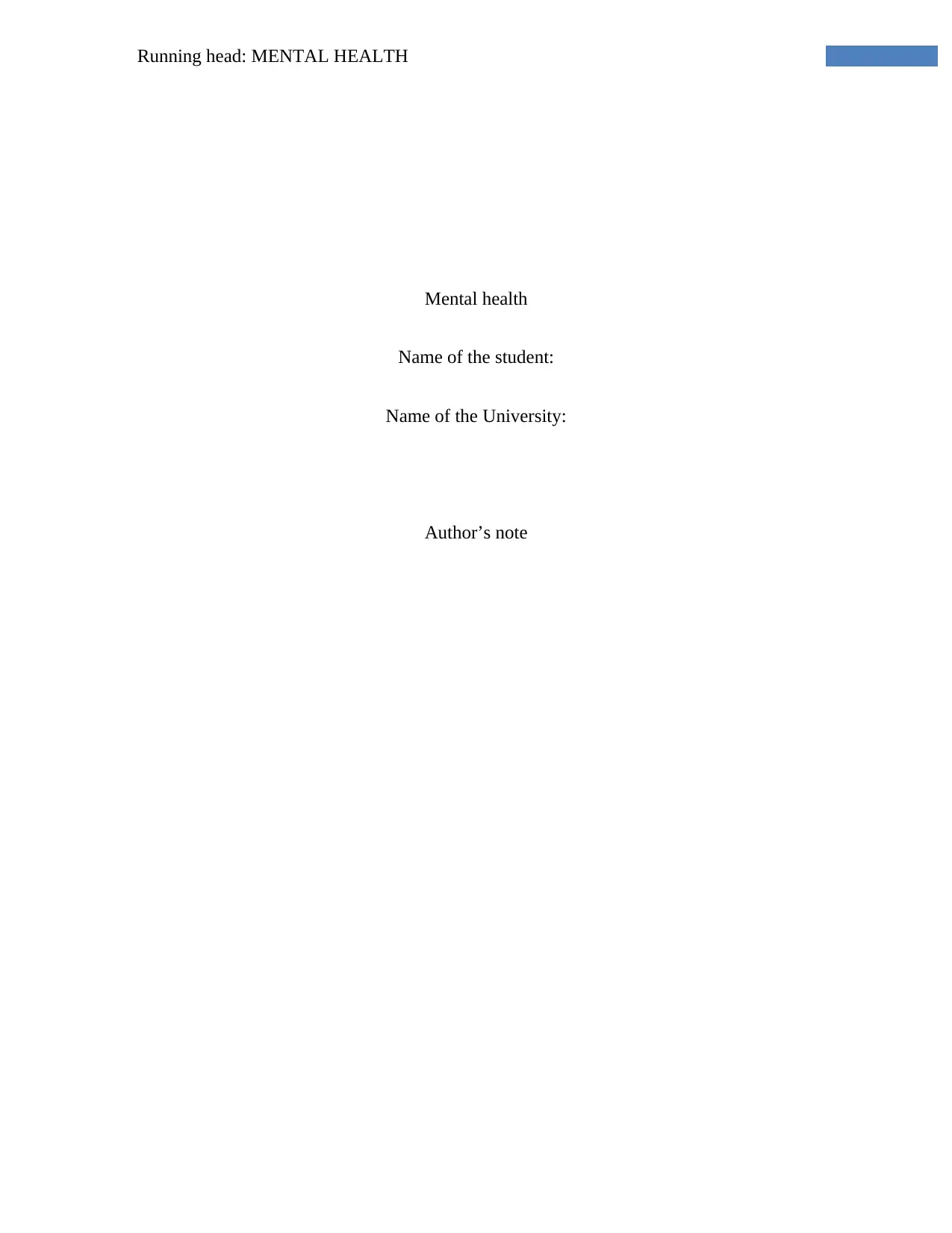
Running head: MENTAL HEALTH
Mental health
Name of the student:
Name of the University:
Author’s note
Mental health
Name of the student:
Name of the University:
Author’s note
Paraphrase This Document
Need a fresh take? Get an instant paraphrase of this document with our AI Paraphraser
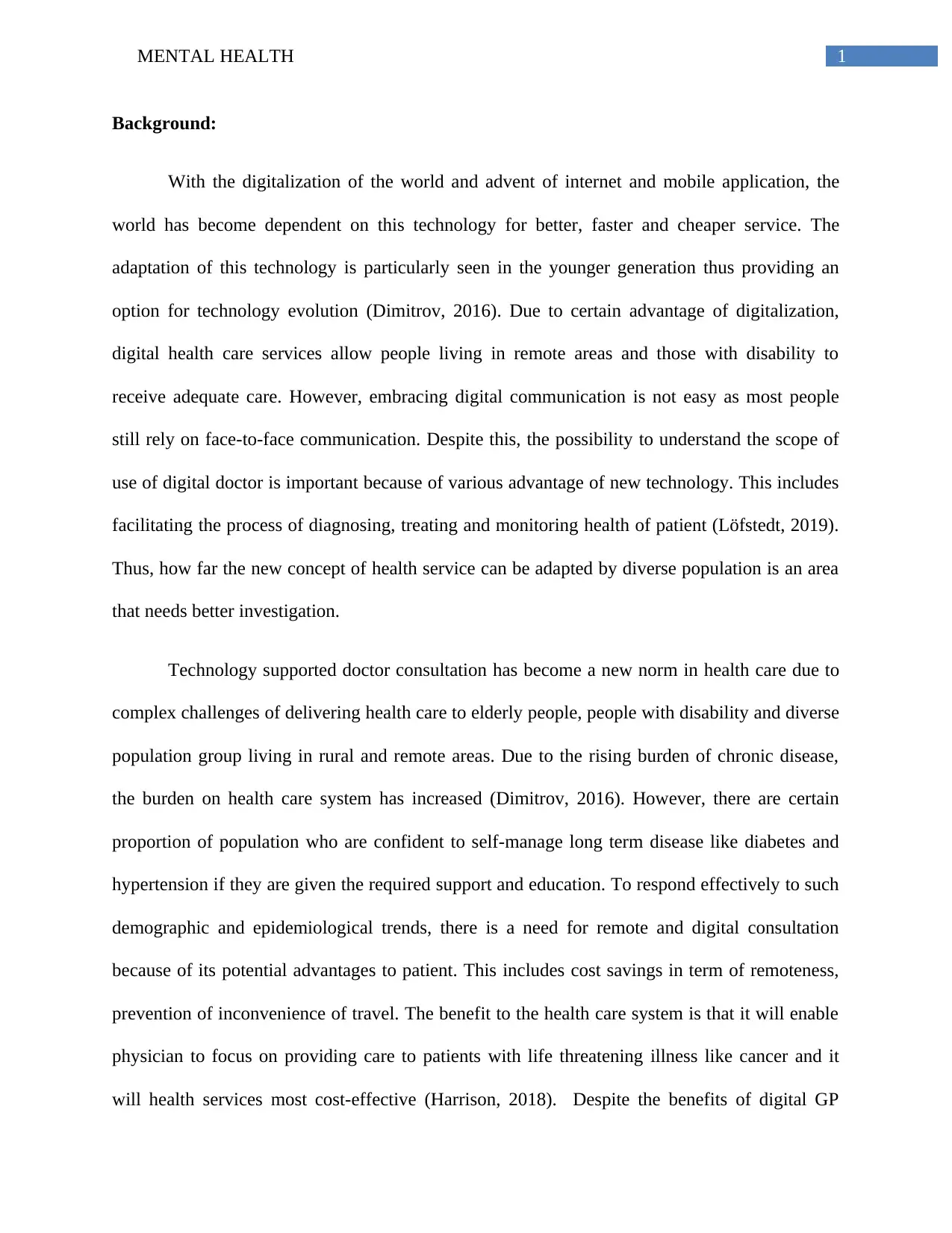
1MENTAL HEALTH
Background:
With the digitalization of the world and advent of internet and mobile application, the
world has become dependent on this technology for better, faster and cheaper service. The
adaptation of this technology is particularly seen in the younger generation thus providing an
option for technology evolution (Dimitrov, 2016). Due to certain advantage of digitalization,
digital health care services allow people living in remote areas and those with disability to
receive adequate care. However, embracing digital communication is not easy as most people
still rely on face-to-face communication. Despite this, the possibility to understand the scope of
use of digital doctor is important because of various advantage of new technology. This includes
facilitating the process of diagnosing, treating and monitoring health of patient (Löfstedt, 2019).
Thus, how far the new concept of health service can be adapted by diverse population is an area
that needs better investigation.
Technology supported doctor consultation has become a new norm in health care due to
complex challenges of delivering health care to elderly people, people with disability and diverse
population group living in rural and remote areas. Due to the rising burden of chronic disease,
the burden on health care system has increased (Dimitrov, 2016). However, there are certain
proportion of population who are confident to self-manage long term disease like diabetes and
hypertension if they are given the required support and education. To respond effectively to such
demographic and epidemiological trends, there is a need for remote and digital consultation
because of its potential advantages to patient. This includes cost savings in term of remoteness,
prevention of inconvenience of travel. The benefit to the health care system is that it will enable
physician to focus on providing care to patients with life threatening illness like cancer and it
will health services most cost-effective (Harrison, 2018). Despite the benefits of digital GP
Background:
With the digitalization of the world and advent of internet and mobile application, the
world has become dependent on this technology for better, faster and cheaper service. The
adaptation of this technology is particularly seen in the younger generation thus providing an
option for technology evolution (Dimitrov, 2016). Due to certain advantage of digitalization,
digital health care services allow people living in remote areas and those with disability to
receive adequate care. However, embracing digital communication is not easy as most people
still rely on face-to-face communication. Despite this, the possibility to understand the scope of
use of digital doctor is important because of various advantage of new technology. This includes
facilitating the process of diagnosing, treating and monitoring health of patient (Löfstedt, 2019).
Thus, how far the new concept of health service can be adapted by diverse population is an area
that needs better investigation.
Technology supported doctor consultation has become a new norm in health care due to
complex challenges of delivering health care to elderly people, people with disability and diverse
population group living in rural and remote areas. Due to the rising burden of chronic disease,
the burden on health care system has increased (Dimitrov, 2016). However, there are certain
proportion of population who are confident to self-manage long term disease like diabetes and
hypertension if they are given the required support and education. To respond effectively to such
demographic and epidemiological trends, there is a need for remote and digital consultation
because of its potential advantages to patient. This includes cost savings in term of remoteness,
prevention of inconvenience of travel. The benefit to the health care system is that it will enable
physician to focus on providing care to patients with life threatening illness like cancer and it
will health services most cost-effective (Harrison, 2018). Despite the benefits of digital GP
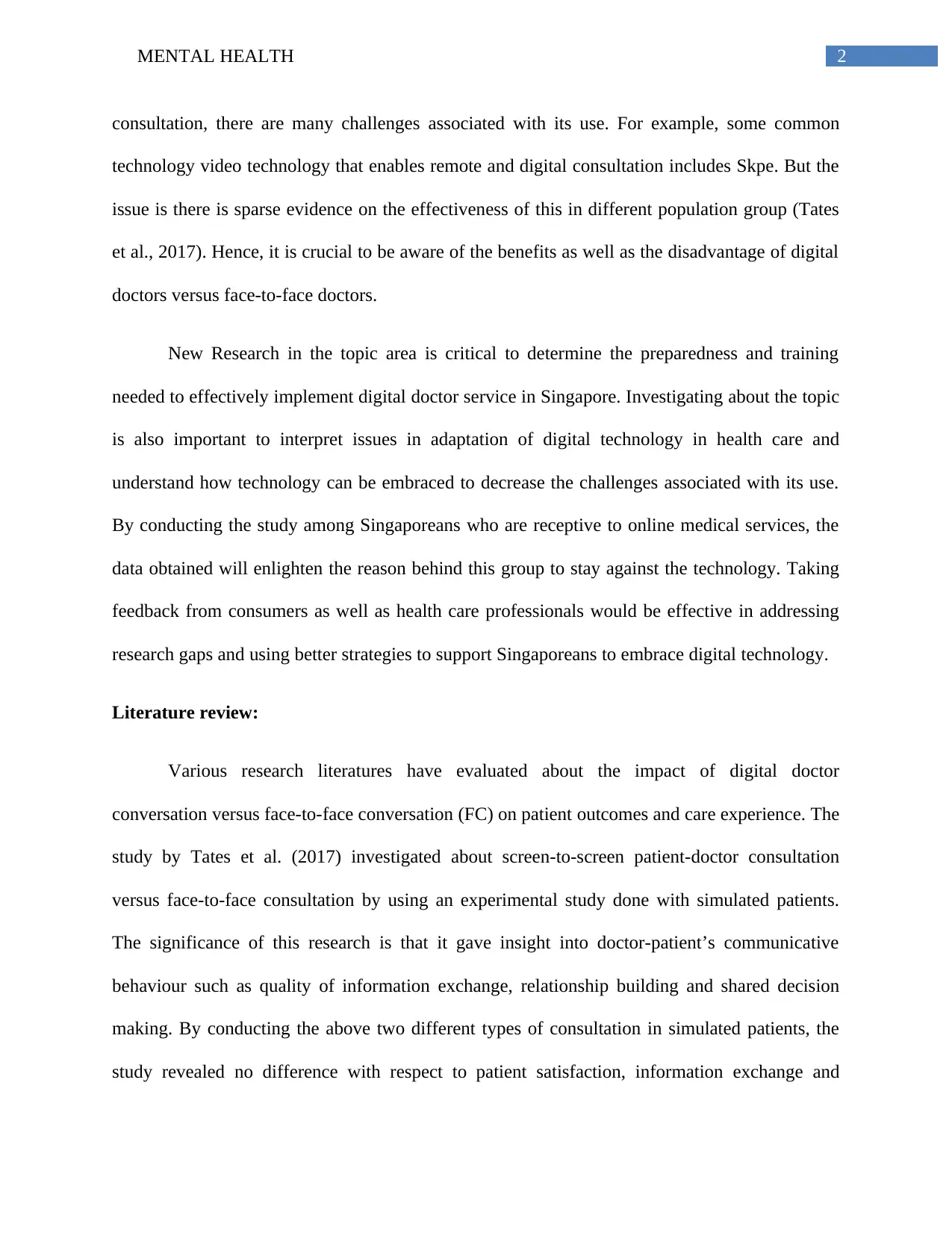
2MENTAL HEALTH
consultation, there are many challenges associated with its use. For example, some common
technology video technology that enables remote and digital consultation includes Skpe. But the
issue is there is sparse evidence on the effectiveness of this in different population group (Tates
et al., 2017). Hence, it is crucial to be aware of the benefits as well as the disadvantage of digital
doctors versus face-to-face doctors.
New Research in the topic area is critical to determine the preparedness and training
needed to effectively implement digital doctor service in Singapore. Investigating about the topic
is also important to interpret issues in adaptation of digital technology in health care and
understand how technology can be embraced to decrease the challenges associated with its use.
By conducting the study among Singaporeans who are receptive to online medical services, the
data obtained will enlighten the reason behind this group to stay against the technology. Taking
feedback from consumers as well as health care professionals would be effective in addressing
research gaps and using better strategies to support Singaporeans to embrace digital technology.
Literature review:
Various research literatures have evaluated about the impact of digital doctor
conversation versus face-to-face conversation (FC) on patient outcomes and care experience. The
study by Tates et al. (2017) investigated about screen-to-screen patient-doctor consultation
versus face-to-face consultation by using an experimental study done with simulated patients.
The significance of this research is that it gave insight into doctor-patient’s communicative
behaviour such as quality of information exchange, relationship building and shared decision
making. By conducting the above two different types of consultation in simulated patients, the
study revealed no difference with respect to patient satisfaction, information exchange and
consultation, there are many challenges associated with its use. For example, some common
technology video technology that enables remote and digital consultation includes Skpe. But the
issue is there is sparse evidence on the effectiveness of this in different population group (Tates
et al., 2017). Hence, it is crucial to be aware of the benefits as well as the disadvantage of digital
doctors versus face-to-face doctors.
New Research in the topic area is critical to determine the preparedness and training
needed to effectively implement digital doctor service in Singapore. Investigating about the topic
is also important to interpret issues in adaptation of digital technology in health care and
understand how technology can be embraced to decrease the challenges associated with its use.
By conducting the study among Singaporeans who are receptive to online medical services, the
data obtained will enlighten the reason behind this group to stay against the technology. Taking
feedback from consumers as well as health care professionals would be effective in addressing
research gaps and using better strategies to support Singaporeans to embrace digital technology.
Literature review:
Various research literatures have evaluated about the impact of digital doctor
conversation versus face-to-face conversation (FC) on patient outcomes and care experience. The
study by Tates et al. (2017) investigated about screen-to-screen patient-doctor consultation
versus face-to-face consultation by using an experimental study done with simulated patients.
The significance of this research is that it gave insight into doctor-patient’s communicative
behaviour such as quality of information exchange, relationship building and shared decision
making. By conducting the above two different types of consultation in simulated patients, the
study revealed no difference with respect to patient satisfaction, information exchange and
⊘ This is a preview!⊘
Do you want full access?
Subscribe today to unlock all pages.

Trusted by 1+ million students worldwide
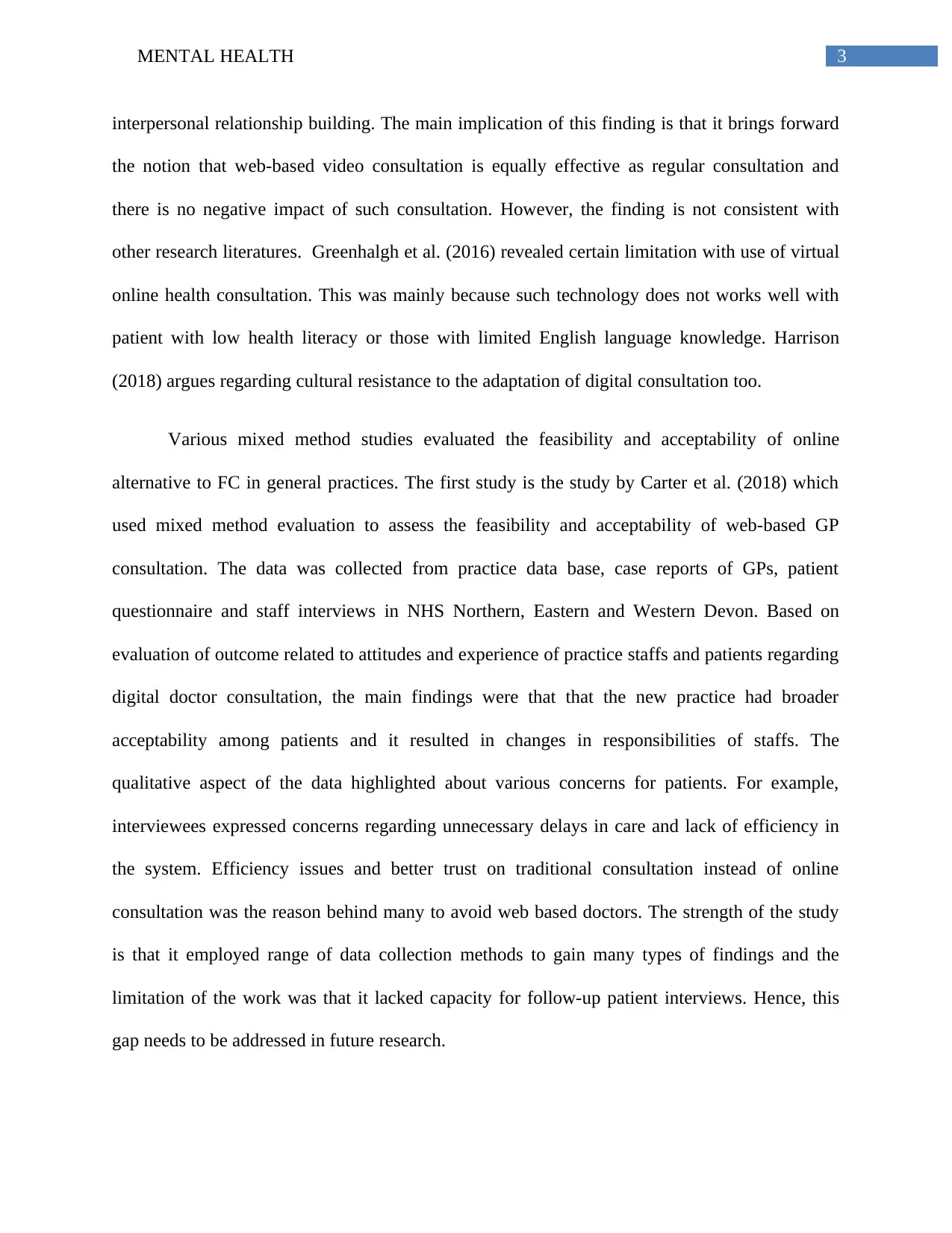
3MENTAL HEALTH
interpersonal relationship building. The main implication of this finding is that it brings forward
the notion that web-based video consultation is equally effective as regular consultation and
there is no negative impact of such consultation. However, the finding is not consistent with
other research literatures. Greenhalgh et al. (2016) revealed certain limitation with use of virtual
online health consultation. This was mainly because such technology does not works well with
patient with low health literacy or those with limited English language knowledge. Harrison
(2018) argues regarding cultural resistance to the adaptation of digital consultation too.
Various mixed method studies evaluated the feasibility and acceptability of online
alternative to FC in general practices. The first study is the study by Carter et al. (2018) which
used mixed method evaluation to assess the feasibility and acceptability of web-based GP
consultation. The data was collected from practice data base, case reports of GPs, patient
questionnaire and staff interviews in NHS Northern, Eastern and Western Devon. Based on
evaluation of outcome related to attitudes and experience of practice staffs and patients regarding
digital doctor consultation, the main findings were that that the new practice had broader
acceptability among patients and it resulted in changes in responsibilities of staffs. The
qualitative aspect of the data highlighted about various concerns for patients. For example,
interviewees expressed concerns regarding unnecessary delays in care and lack of efficiency in
the system. Efficiency issues and better trust on traditional consultation instead of online
consultation was the reason behind many to avoid web based doctors. The strength of the study
is that it employed range of data collection methods to gain many types of findings and the
limitation of the work was that it lacked capacity for follow-up patient interviews. Hence, this
gap needs to be addressed in future research.
interpersonal relationship building. The main implication of this finding is that it brings forward
the notion that web-based video consultation is equally effective as regular consultation and
there is no negative impact of such consultation. However, the finding is not consistent with
other research literatures. Greenhalgh et al. (2016) revealed certain limitation with use of virtual
online health consultation. This was mainly because such technology does not works well with
patient with low health literacy or those with limited English language knowledge. Harrison
(2018) argues regarding cultural resistance to the adaptation of digital consultation too.
Various mixed method studies evaluated the feasibility and acceptability of online
alternative to FC in general practices. The first study is the study by Carter et al. (2018) which
used mixed method evaluation to assess the feasibility and acceptability of web-based GP
consultation. The data was collected from practice data base, case reports of GPs, patient
questionnaire and staff interviews in NHS Northern, Eastern and Western Devon. Based on
evaluation of outcome related to attitudes and experience of practice staffs and patients regarding
digital doctor consultation, the main findings were that that the new practice had broader
acceptability among patients and it resulted in changes in responsibilities of staffs. The
qualitative aspect of the data highlighted about various concerns for patients. For example,
interviewees expressed concerns regarding unnecessary delays in care and lack of efficiency in
the system. Efficiency issues and better trust on traditional consultation instead of online
consultation was the reason behind many to avoid web based doctors. The strength of the study
is that it employed range of data collection methods to gain many types of findings and the
limitation of the work was that it lacked capacity for follow-up patient interviews. Hence, this
gap needs to be addressed in future research.
Paraphrase This Document
Need a fresh take? Get an instant paraphrase of this document with our AI Paraphraser
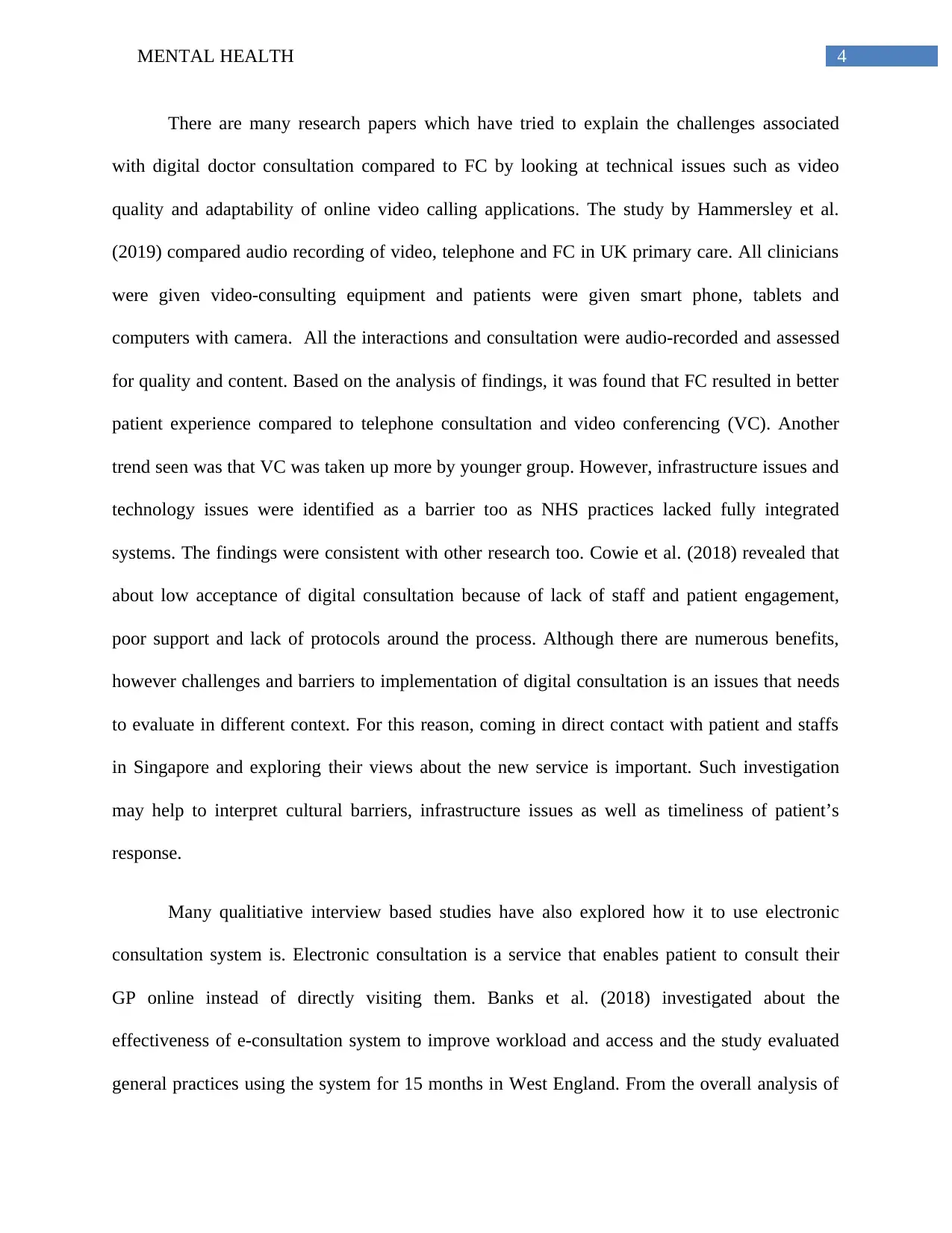
4MENTAL HEALTH
There are many research papers which have tried to explain the challenges associated
with digital doctor consultation compared to FC by looking at technical issues such as video
quality and adaptability of online video calling applications. The study by Hammersley et al.
(2019) compared audio recording of video, telephone and FC in UK primary care. All clinicians
were given video-consulting equipment and patients were given smart phone, tablets and
computers with camera. All the interactions and consultation were audio-recorded and assessed
for quality and content. Based on the analysis of findings, it was found that FC resulted in better
patient experience compared to telephone consultation and video conferencing (VC). Another
trend seen was that VC was taken up more by younger group. However, infrastructure issues and
technology issues were identified as a barrier too as NHS practices lacked fully integrated
systems. The findings were consistent with other research too. Cowie et al. (2018) revealed that
about low acceptance of digital consultation because of lack of staff and patient engagement,
poor support and lack of protocols around the process. Although there are numerous benefits,
however challenges and barriers to implementation of digital consultation is an issues that needs
to evaluate in different context. For this reason, coming in direct contact with patient and staffs
in Singapore and exploring their views about the new service is important. Such investigation
may help to interpret cultural barriers, infrastructure issues as well as timeliness of patient’s
response.
Many qualitiative interview based studies have also explored how it to use electronic
consultation system is. Electronic consultation is a service that enables patient to consult their
GP online instead of directly visiting them. Banks et al. (2018) investigated about the
effectiveness of e-consultation system to improve workload and access and the study evaluated
general practices using the system for 15 months in West England. From the overall analysis of
There are many research papers which have tried to explain the challenges associated
with digital doctor consultation compared to FC by looking at technical issues such as video
quality and adaptability of online video calling applications. The study by Hammersley et al.
(2019) compared audio recording of video, telephone and FC in UK primary care. All clinicians
were given video-consulting equipment and patients were given smart phone, tablets and
computers with camera. All the interactions and consultation were audio-recorded and assessed
for quality and content. Based on the analysis of findings, it was found that FC resulted in better
patient experience compared to telephone consultation and video conferencing (VC). Another
trend seen was that VC was taken up more by younger group. However, infrastructure issues and
technology issues were identified as a barrier too as NHS practices lacked fully integrated
systems. The findings were consistent with other research too. Cowie et al. (2018) revealed that
about low acceptance of digital consultation because of lack of staff and patient engagement,
poor support and lack of protocols around the process. Although there are numerous benefits,
however challenges and barriers to implementation of digital consultation is an issues that needs
to evaluate in different context. For this reason, coming in direct contact with patient and staffs
in Singapore and exploring their views about the new service is important. Such investigation
may help to interpret cultural barriers, infrastructure issues as well as timeliness of patient’s
response.
Many qualitiative interview based studies have also explored how it to use electronic
consultation system is. Electronic consultation is a service that enables patient to consult their
GP online instead of directly visiting them. Banks et al. (2018) investigated about the
effectiveness of e-consultation system to improve workload and access and the study evaluated
general practices using the system for 15 months in West England. From the overall analysis of
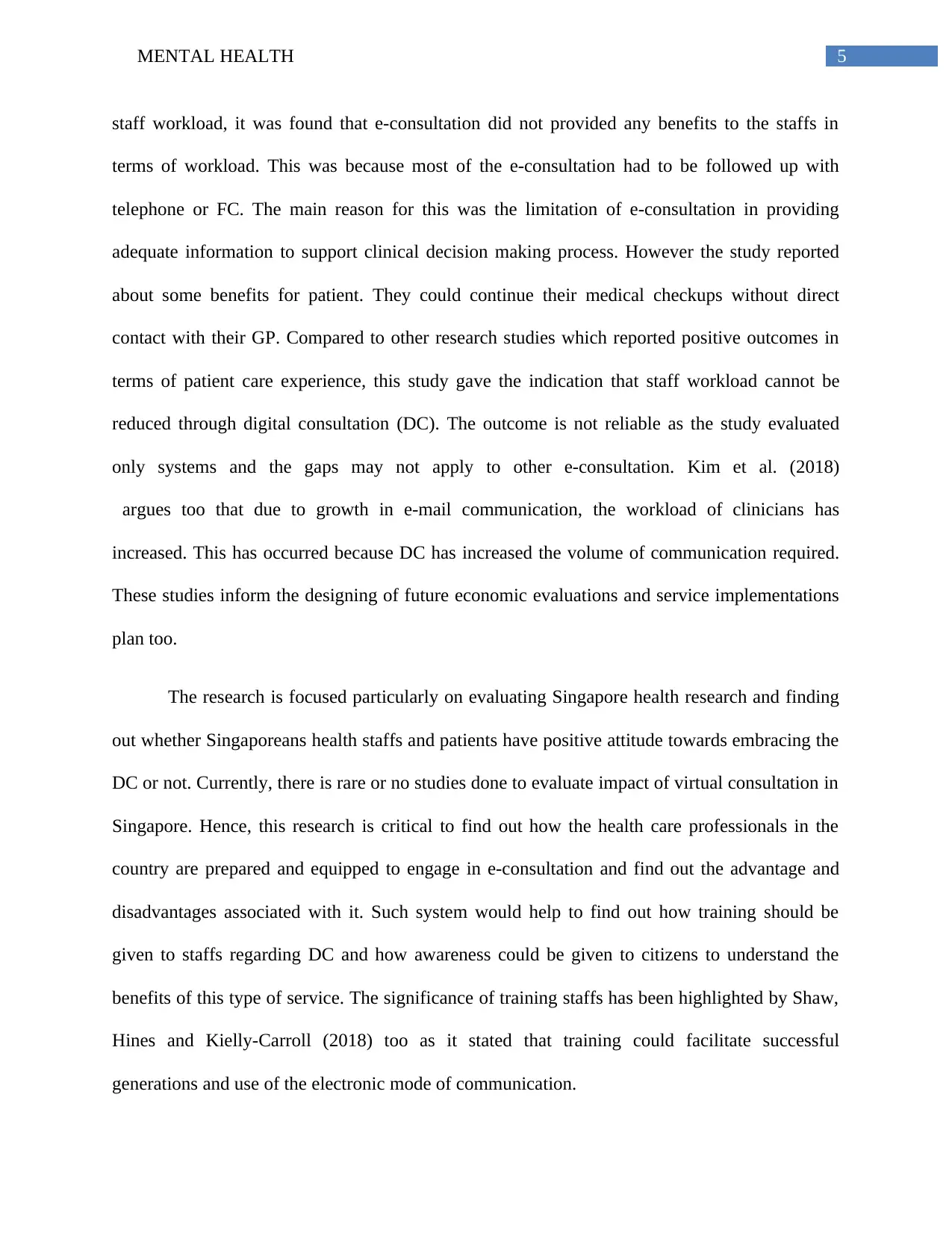
5MENTAL HEALTH
staff workload, it was found that e-consultation did not provided any benefits to the staffs in
terms of workload. This was because most of the e-consultation had to be followed up with
telephone or FC. The main reason for this was the limitation of e-consultation in providing
adequate information to support clinical decision making process. However the study reported
about some benefits for patient. They could continue their medical checkups without direct
contact with their GP. Compared to other research studies which reported positive outcomes in
terms of patient care experience, this study gave the indication that staff workload cannot be
reduced through digital consultation (DC). The outcome is not reliable as the study evaluated
only systems and the gaps may not apply to other e-consultation. Kim et al. (2018)
argues too that due to growth in e-mail communication, the workload of clinicians has
increased. This has occurred because DC has increased the volume of communication required.
These studies inform the designing of future economic evaluations and service implementations
plan too.
The research is focused particularly on evaluating Singapore health research and finding
out whether Singaporeans health staffs and patients have positive attitude towards embracing the
DC or not. Currently, there is rare or no studies done to evaluate impact of virtual consultation in
Singapore. Hence, this research is critical to find out how the health care professionals in the
country are prepared and equipped to engage in e-consultation and find out the advantage and
disadvantages associated with it. Such system would help to find out how training should be
given to staffs regarding DC and how awareness could be given to citizens to understand the
benefits of this type of service. The significance of training staffs has been highlighted by Shaw,
Hines and Kielly-Carroll (2018) too as it stated that training could facilitate successful
generations and use of the electronic mode of communication.
staff workload, it was found that e-consultation did not provided any benefits to the staffs in
terms of workload. This was because most of the e-consultation had to be followed up with
telephone or FC. The main reason for this was the limitation of e-consultation in providing
adequate information to support clinical decision making process. However the study reported
about some benefits for patient. They could continue their medical checkups without direct
contact with their GP. Compared to other research studies which reported positive outcomes in
terms of patient care experience, this study gave the indication that staff workload cannot be
reduced through digital consultation (DC). The outcome is not reliable as the study evaluated
only systems and the gaps may not apply to other e-consultation. Kim et al. (2018)
argues too that due to growth in e-mail communication, the workload of clinicians has
increased. This has occurred because DC has increased the volume of communication required.
These studies inform the designing of future economic evaluations and service implementations
plan too.
The research is focused particularly on evaluating Singapore health research and finding
out whether Singaporeans health staffs and patients have positive attitude towards embracing the
DC or not. Currently, there is rare or no studies done to evaluate impact of virtual consultation in
Singapore. Hence, this research is critical to find out how the health care professionals in the
country are prepared and equipped to engage in e-consultation and find out the advantage and
disadvantages associated with it. Such system would help to find out how training should be
given to staffs regarding DC and how awareness could be given to citizens to understand the
benefits of this type of service. The significance of training staffs has been highlighted by Shaw,
Hines and Kielly-Carroll (2018) too as it stated that training could facilitate successful
generations and use of the electronic mode of communication.
⊘ This is a preview!⊘
Do you want full access?
Subscribe today to unlock all pages.

Trusted by 1+ million students worldwide
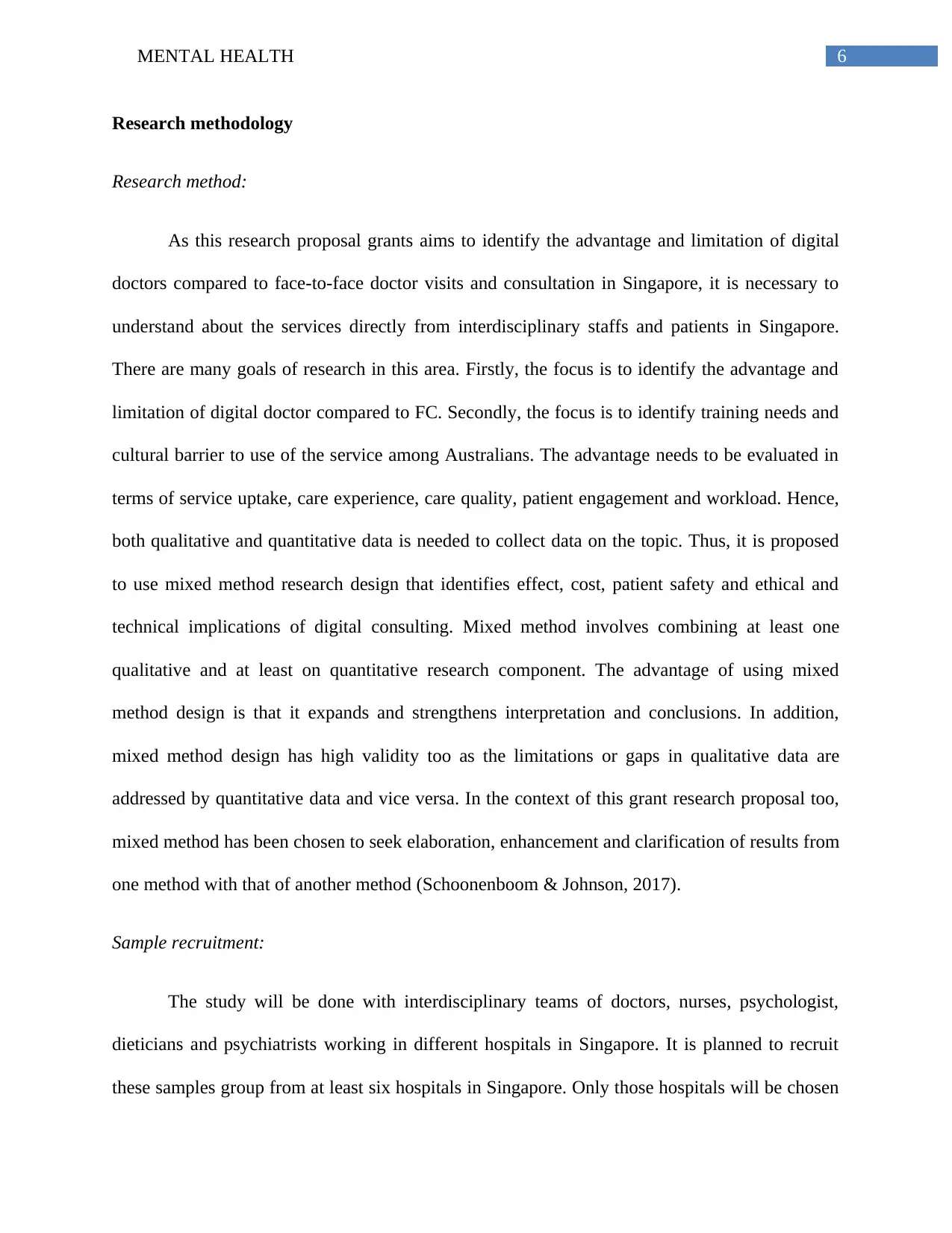
6MENTAL HEALTH
Research methodology
Research method:
As this research proposal grants aims to identify the advantage and limitation of digital
doctors compared to face-to-face doctor visits and consultation in Singapore, it is necessary to
understand about the services directly from interdisciplinary staffs and patients in Singapore.
There are many goals of research in this area. Firstly, the focus is to identify the advantage and
limitation of digital doctor compared to FC. Secondly, the focus is to identify training needs and
cultural barrier to use of the service among Australians. The advantage needs to be evaluated in
terms of service uptake, care experience, care quality, patient engagement and workload. Hence,
both qualitative and quantitative data is needed to collect data on the topic. Thus, it is proposed
to use mixed method research design that identifies effect, cost, patient safety and ethical and
technical implications of digital consulting. Mixed method involves combining at least one
qualitative and at least on quantitative research component. The advantage of using mixed
method design is that it expands and strengthens interpretation and conclusions. In addition,
mixed method design has high validity too as the limitations or gaps in qualitative data are
addressed by quantitative data and vice versa. In the context of this grant research proposal too,
mixed method has been chosen to seek elaboration, enhancement and clarification of results from
one method with that of another method (Schoonenboom & Johnson, 2017).
Sample recruitment:
The study will be done with interdisciplinary teams of doctors, nurses, psychologist,
dieticians and psychiatrists working in different hospitals in Singapore. It is planned to recruit
these samples group from at least six hospitals in Singapore. Only those hospitals will be chosen
Research methodology
Research method:
As this research proposal grants aims to identify the advantage and limitation of digital
doctors compared to face-to-face doctor visits and consultation in Singapore, it is necessary to
understand about the services directly from interdisciplinary staffs and patients in Singapore.
There are many goals of research in this area. Firstly, the focus is to identify the advantage and
limitation of digital doctor compared to FC. Secondly, the focus is to identify training needs and
cultural barrier to use of the service among Australians. The advantage needs to be evaluated in
terms of service uptake, care experience, care quality, patient engagement and workload. Hence,
both qualitative and quantitative data is needed to collect data on the topic. Thus, it is proposed
to use mixed method research design that identifies effect, cost, patient safety and ethical and
technical implications of digital consulting. Mixed method involves combining at least one
qualitative and at least on quantitative research component. The advantage of using mixed
method design is that it expands and strengthens interpretation and conclusions. In addition,
mixed method design has high validity too as the limitations or gaps in qualitative data are
addressed by quantitative data and vice versa. In the context of this grant research proposal too,
mixed method has been chosen to seek elaboration, enhancement and clarification of results from
one method with that of another method (Schoonenboom & Johnson, 2017).
Sample recruitment:
The study will be done with interdisciplinary teams of doctors, nurses, psychologist,
dieticians and psychiatrists working in different hospitals in Singapore. It is planned to recruit
these samples group from at least six hospitals in Singapore. Only those hospitals will be chosen
Paraphrase This Document
Need a fresh take? Get an instant paraphrase of this document with our AI Paraphraser
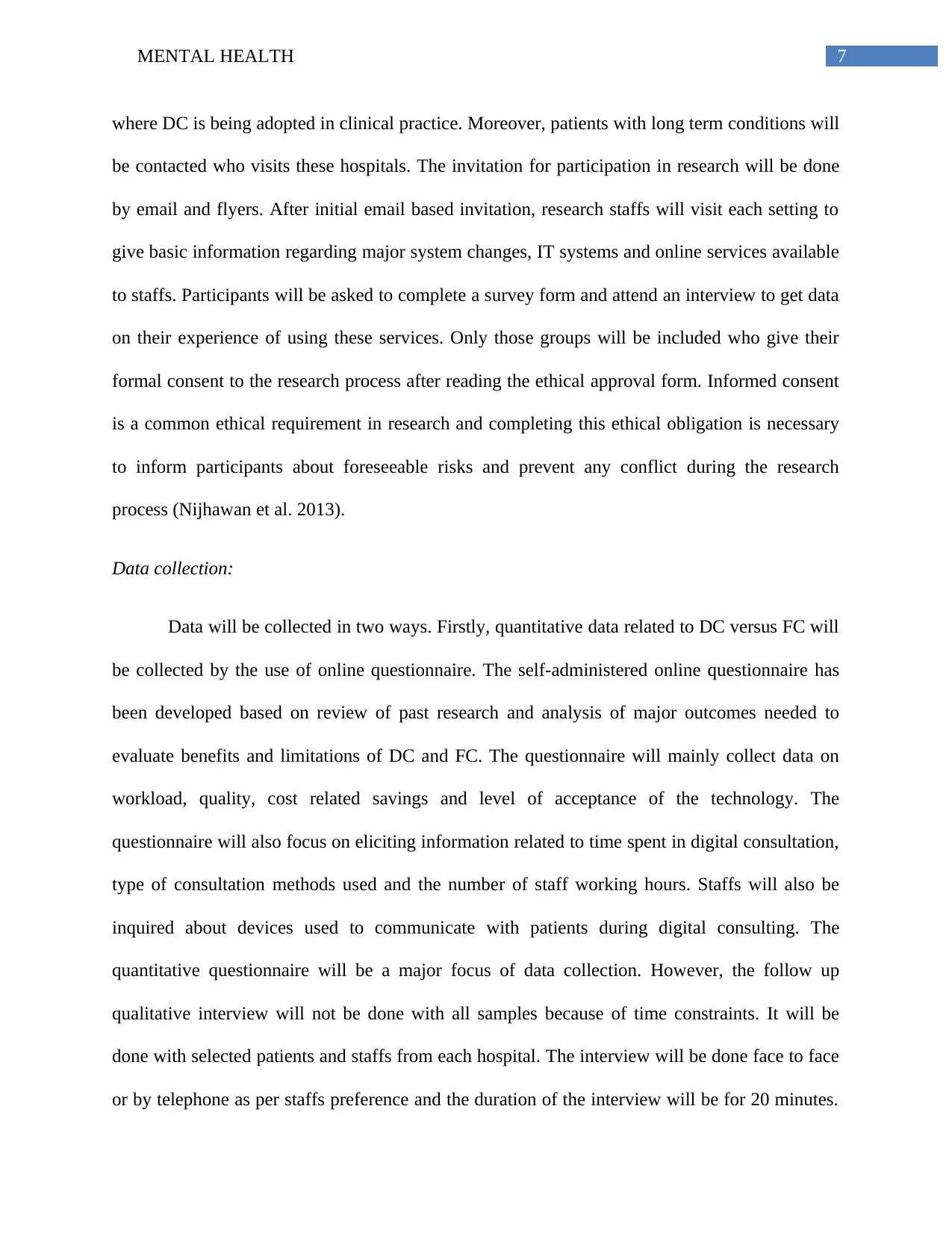
7MENTAL HEALTH
where DC is being adopted in clinical practice. Moreover, patients with long term conditions will
be contacted who visits these hospitals. The invitation for participation in research will be done
by email and flyers. After initial email based invitation, research staffs will visit each setting to
give basic information regarding major system changes, IT systems and online services available
to staffs. Participants will be asked to complete a survey form and attend an interview to get data
on their experience of using these services. Only those groups will be included who give their
formal consent to the research process after reading the ethical approval form. Informed consent
is a common ethical requirement in research and completing this ethical obligation is necessary
to inform participants about foreseeable risks and prevent any conflict during the research
process (Nijhawan et al. 2013).
Data collection:
Data will be collected in two ways. Firstly, quantitative data related to DC versus FC will
be collected by the use of online questionnaire. The self-administered online questionnaire has
been developed based on review of past research and analysis of major outcomes needed to
evaluate benefits and limitations of DC and FC. The questionnaire will mainly collect data on
workload, quality, cost related savings and level of acceptance of the technology. The
questionnaire will also focus on eliciting information related to time spent in digital consultation,
type of consultation methods used and the number of staff working hours. Staffs will also be
inquired about devices used to communicate with patients during digital consulting. The
quantitative questionnaire will be a major focus of data collection. However, the follow up
qualitative interview will not be done with all samples because of time constraints. It will be
done with selected patients and staffs from each hospital. The interview will be done face to face
or by telephone as per staffs preference and the duration of the interview will be for 20 minutes.
where DC is being adopted in clinical practice. Moreover, patients with long term conditions will
be contacted who visits these hospitals. The invitation for participation in research will be done
by email and flyers. After initial email based invitation, research staffs will visit each setting to
give basic information regarding major system changes, IT systems and online services available
to staffs. Participants will be asked to complete a survey form and attend an interview to get data
on their experience of using these services. Only those groups will be included who give their
formal consent to the research process after reading the ethical approval form. Informed consent
is a common ethical requirement in research and completing this ethical obligation is necessary
to inform participants about foreseeable risks and prevent any conflict during the research
process (Nijhawan et al. 2013).
Data collection:
Data will be collected in two ways. Firstly, quantitative data related to DC versus FC will
be collected by the use of online questionnaire. The self-administered online questionnaire has
been developed based on review of past research and analysis of major outcomes needed to
evaluate benefits and limitations of DC and FC. The questionnaire will mainly collect data on
workload, quality, cost related savings and level of acceptance of the technology. The
questionnaire will also focus on eliciting information related to time spent in digital consultation,
type of consultation methods used and the number of staff working hours. Staffs will also be
inquired about devices used to communicate with patients during digital consulting. The
quantitative questionnaire will be a major focus of data collection. However, the follow up
qualitative interview will not be done with all samples because of time constraints. It will be
done with selected patients and staffs from each hospital. The interview will be done face to face
or by telephone as per staffs preference and the duration of the interview will be for 20 minutes.
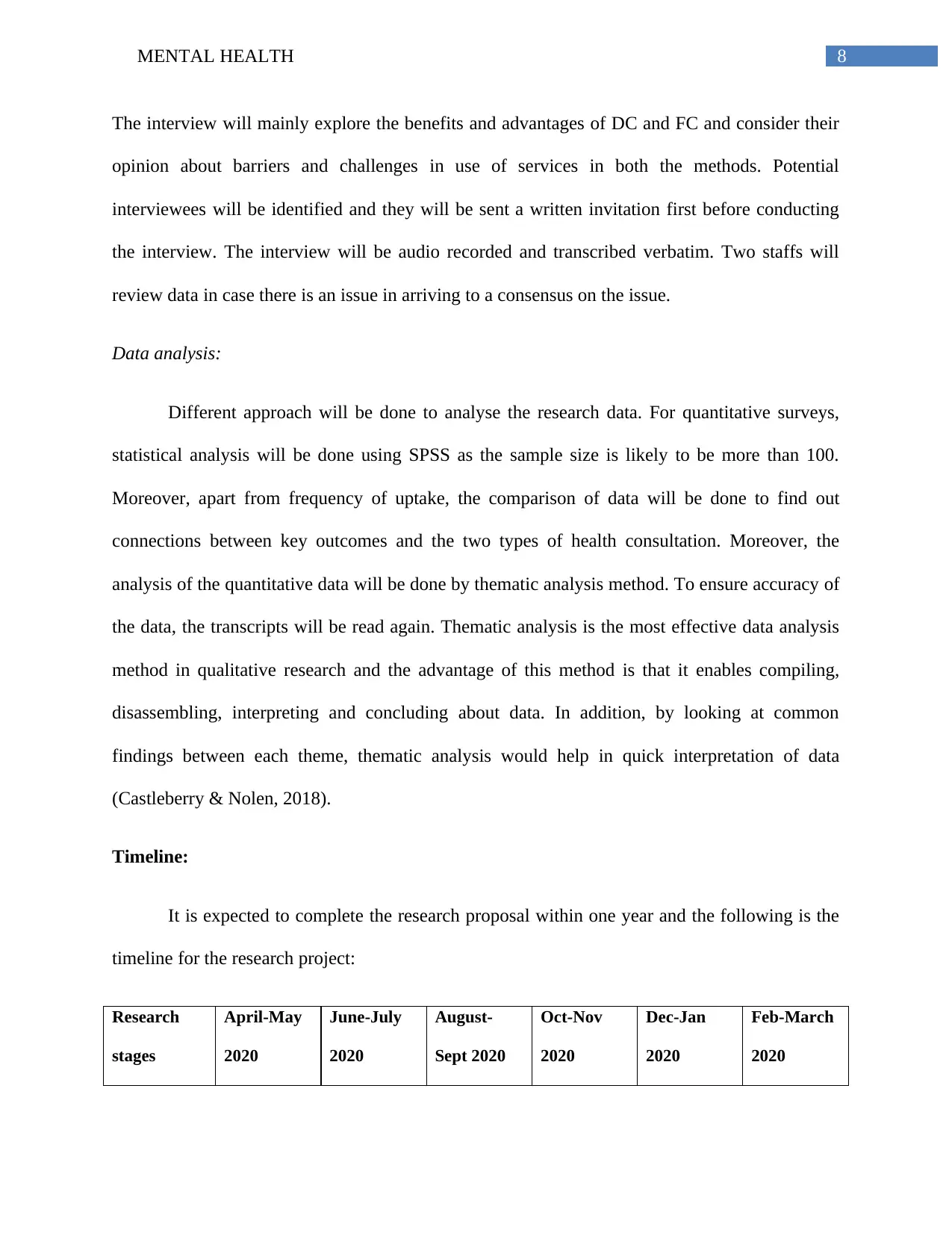
8MENTAL HEALTH
The interview will mainly explore the benefits and advantages of DC and FC and consider their
opinion about barriers and challenges in use of services in both the methods. Potential
interviewees will be identified and they will be sent a written invitation first before conducting
the interview. The interview will be audio recorded and transcribed verbatim. Two staffs will
review data in case there is an issue in arriving to a consensus on the issue.
Data analysis:
Different approach will be done to analyse the research data. For quantitative surveys,
statistical analysis will be done using SPSS as the sample size is likely to be more than 100.
Moreover, apart from frequency of uptake, the comparison of data will be done to find out
connections between key outcomes and the two types of health consultation. Moreover, the
analysis of the quantitative data will be done by thematic analysis method. To ensure accuracy of
the data, the transcripts will be read again. Thematic analysis is the most effective data analysis
method in qualitative research and the advantage of this method is that it enables compiling,
disassembling, interpreting and concluding about data. In addition, by looking at common
findings between each theme, thematic analysis would help in quick interpretation of data
(Castleberry & Nolen, 2018).
Timeline:
It is expected to complete the research proposal within one year and the following is the
timeline for the research project:
Research
stages
April-May
2020
June-July
2020
August-
Sept 2020
Oct-Nov
2020
Dec-Jan
2020
Feb-March
2020
The interview will mainly explore the benefits and advantages of DC and FC and consider their
opinion about barriers and challenges in use of services in both the methods. Potential
interviewees will be identified and they will be sent a written invitation first before conducting
the interview. The interview will be audio recorded and transcribed verbatim. Two staffs will
review data in case there is an issue in arriving to a consensus on the issue.
Data analysis:
Different approach will be done to analyse the research data. For quantitative surveys,
statistical analysis will be done using SPSS as the sample size is likely to be more than 100.
Moreover, apart from frequency of uptake, the comparison of data will be done to find out
connections between key outcomes and the two types of health consultation. Moreover, the
analysis of the quantitative data will be done by thematic analysis method. To ensure accuracy of
the data, the transcripts will be read again. Thematic analysis is the most effective data analysis
method in qualitative research and the advantage of this method is that it enables compiling,
disassembling, interpreting and concluding about data. In addition, by looking at common
findings between each theme, thematic analysis would help in quick interpretation of data
(Castleberry & Nolen, 2018).
Timeline:
It is expected to complete the research proposal within one year and the following is the
timeline for the research project:
Research
stages
April-May
2020
June-July
2020
August-
Sept 2020
Oct-Nov
2020
Dec-Jan
2020
Feb-March
2020
⊘ This is a preview!⊘
Do you want full access?
Subscribe today to unlock all pages.

Trusted by 1+ million students worldwide
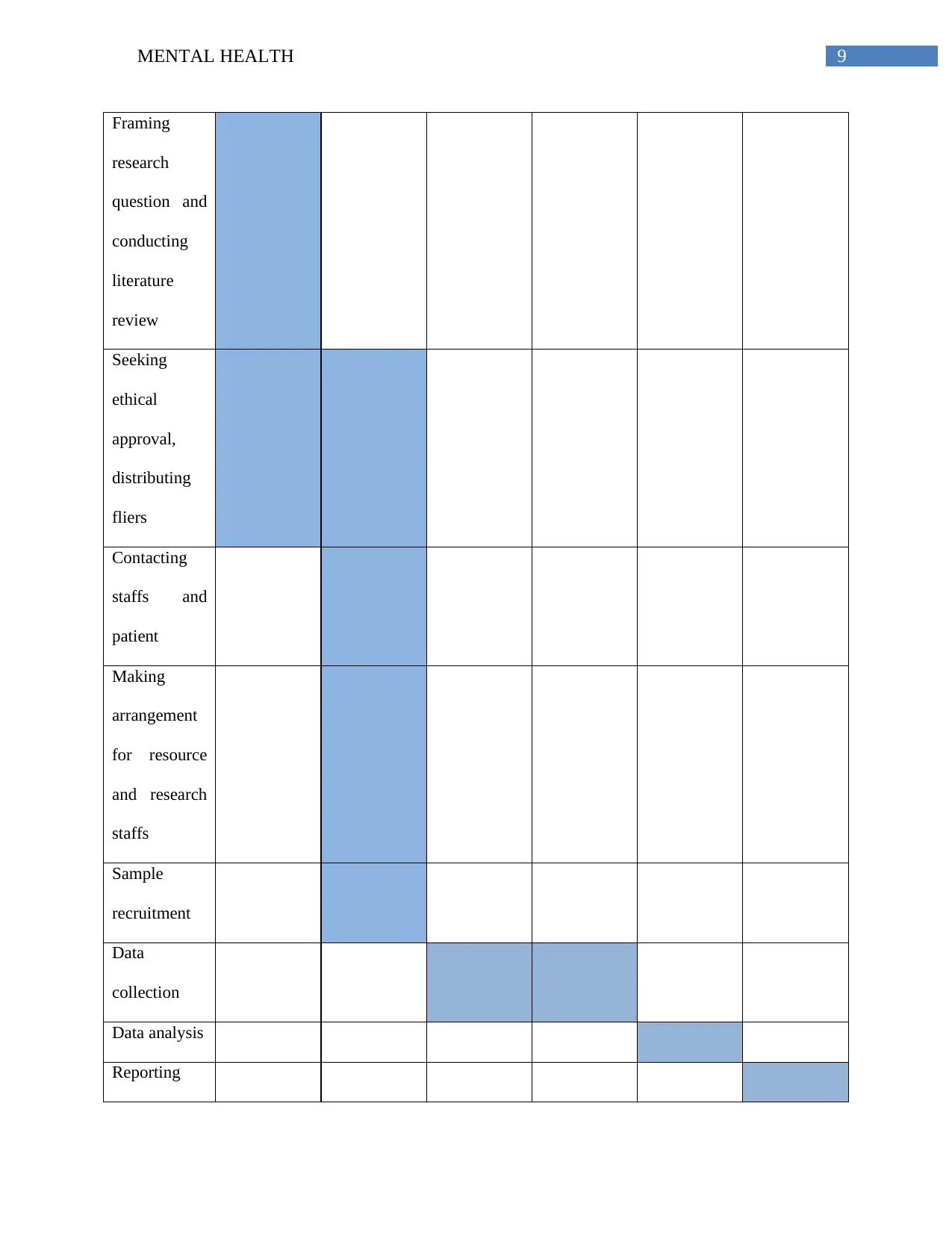
9MENTAL HEALTH
Framing
research
question and
conducting
literature
review
Seeking
ethical
approval,
distributing
fliers
Contacting
staffs and
patient
Making
arrangement
for resource
and research
staffs
Sample
recruitment
Data
collection
Data analysis
Reporting
Framing
research
question and
conducting
literature
review
Seeking
ethical
approval,
distributing
fliers
Contacting
staffs and
patient
Making
arrangement
for resource
and research
staffs
Sample
recruitment
Data
collection
Data analysis
Reporting
Paraphrase This Document
Need a fresh take? Get an instant paraphrase of this document with our AI Paraphraser
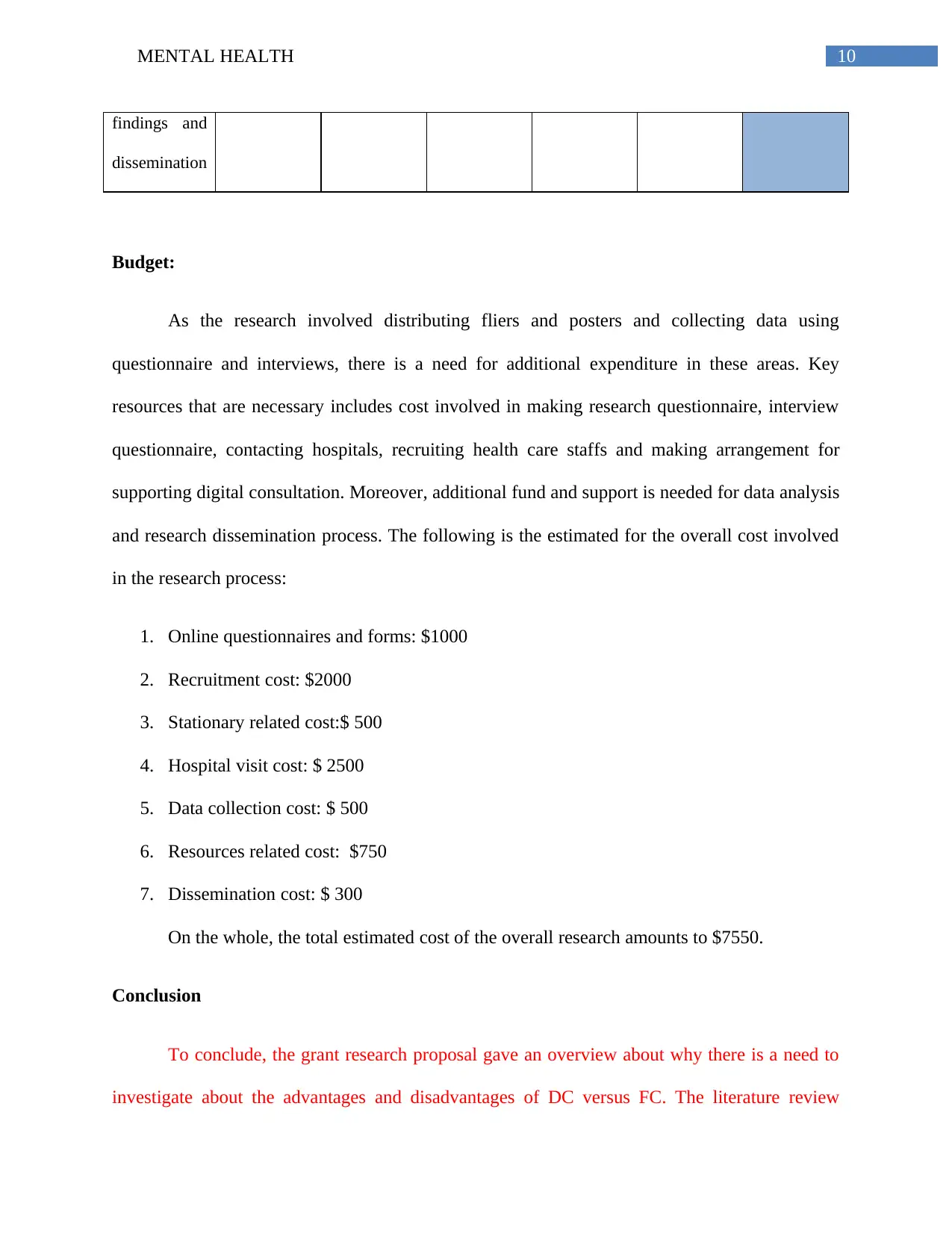
10MENTAL HEALTH
findings and
dissemination
Budget:
As the research involved distributing fliers and posters and collecting data using
questionnaire and interviews, there is a need for additional expenditure in these areas. Key
resources that are necessary includes cost involved in making research questionnaire, interview
questionnaire, contacting hospitals, recruiting health care staffs and making arrangement for
supporting digital consultation. Moreover, additional fund and support is needed for data analysis
and research dissemination process. The following is the estimated for the overall cost involved
in the research process:
1. Online questionnaires and forms: $1000
2. Recruitment cost: $2000
3. Stationary related cost:$ 500
4. Hospital visit cost: $ 2500
5. Data collection cost: $ 500
6. Resources related cost: $750
7. Dissemination cost: $ 300
On the whole, the total estimated cost of the overall research amounts to $7550.
Conclusion
To conclude, the grant research proposal gave an overview about why there is a need to
investigate about the advantages and disadvantages of DC versus FC. The literature review
findings and
dissemination
Budget:
As the research involved distributing fliers and posters and collecting data using
questionnaire and interviews, there is a need for additional expenditure in these areas. Key
resources that are necessary includes cost involved in making research questionnaire, interview
questionnaire, contacting hospitals, recruiting health care staffs and making arrangement for
supporting digital consultation. Moreover, additional fund and support is needed for data analysis
and research dissemination process. The following is the estimated for the overall cost involved
in the research process:
1. Online questionnaires and forms: $1000
2. Recruitment cost: $2000
3. Stationary related cost:$ 500
4. Hospital visit cost: $ 2500
5. Data collection cost: $ 500
6. Resources related cost: $750
7. Dissemination cost: $ 300
On the whole, the total estimated cost of the overall research amounts to $7550.
Conclusion
To conclude, the grant research proposal gave an overview about why there is a need to
investigate about the advantages and disadvantages of DC versus FC. The literature review
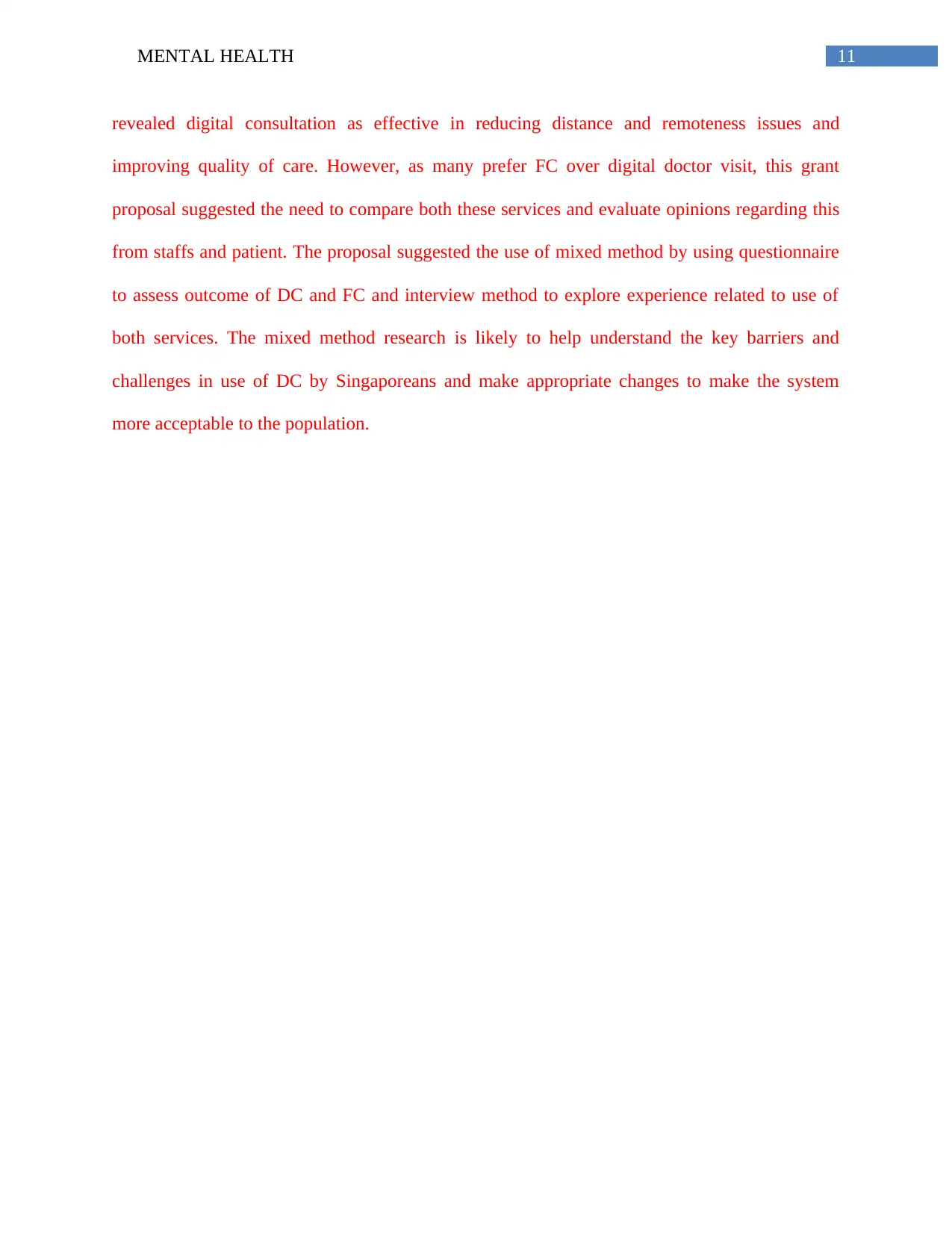
11MENTAL HEALTH
revealed digital consultation as effective in reducing distance and remoteness issues and
improving quality of care. However, as many prefer FC over digital doctor visit, this grant
proposal suggested the need to compare both these services and evaluate opinions regarding this
from staffs and patient. The proposal suggested the use of mixed method by using questionnaire
to assess outcome of DC and FC and interview method to explore experience related to use of
both services. The mixed method research is likely to help understand the key barriers and
challenges in use of DC by Singaporeans and make appropriate changes to make the system
more acceptable to the population.
revealed digital consultation as effective in reducing distance and remoteness issues and
improving quality of care. However, as many prefer FC over digital doctor visit, this grant
proposal suggested the need to compare both these services and evaluate opinions regarding this
from staffs and patient. The proposal suggested the use of mixed method by using questionnaire
to assess outcome of DC and FC and interview method to explore experience related to use of
both services. The mixed method research is likely to help understand the key barriers and
challenges in use of DC by Singaporeans and make appropriate changes to make the system
more acceptable to the population.
⊘ This is a preview!⊘
Do you want full access?
Subscribe today to unlock all pages.

Trusted by 1+ million students worldwide
1 out of 15
Related Documents
Your All-in-One AI-Powered Toolkit for Academic Success.
+13062052269
info@desklib.com
Available 24*7 on WhatsApp / Email
![[object Object]](/_next/static/media/star-bottom.7253800d.svg)
Unlock your academic potential
Copyright © 2020–2025 A2Z Services. All Rights Reserved. Developed and managed by ZUCOL.





